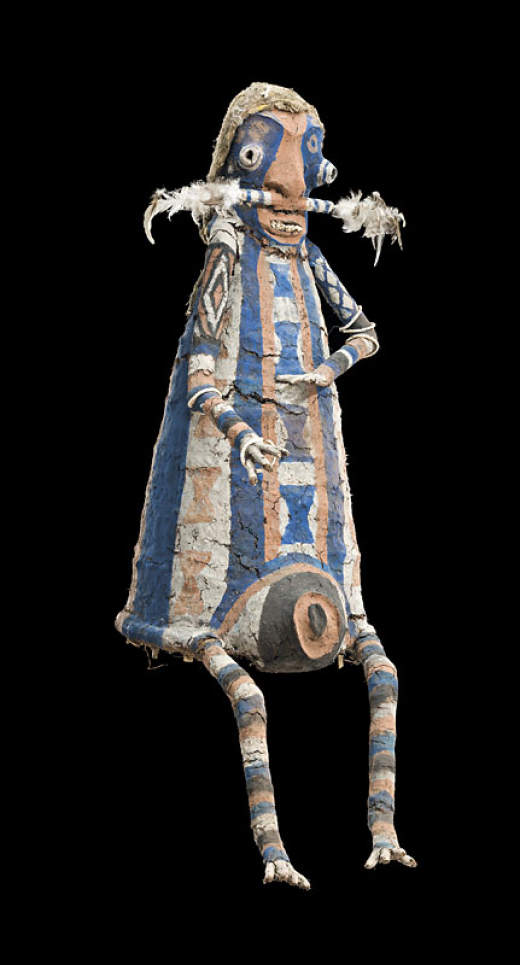A Female Body Mask (Nevimbumbao)
A Female Body Mask (Nevimbumbao)Estimate $30,000 – $50,000
SOUTH-WEST BAY, MALAKULA, VANUATU
tree fern, bamboo, wood structure with plant fibre covering overmodelled with clay, dog teeth, boars tusks, shell (conus or tridacna), spider web, chicken feathers, natural pigments
HEIGHT: 153CM
Provenance:
Collected at South-West Bay, Malakula, circa 1967
Private collection
Cf. For illustrations of the Picasso Nevimbumbao in situ in the artist's studio at villa La Californie in Cannes, see William Rubin (ed.), Primitivism in 20th Century Art, New York: The Museum of Modern Art, 1984, Volume 1, pp.332-33, and Anne Baldassari and Philippe Saunier, Picasso and His Collection, Brisbane: Art Exhibitions Australia and The Queensland Art Gallery, 2008, p.293; For a discussion of Picasso's Nevimbumbao and it's ‘meaning', see Philippe Peltier, ‘the Nevimbumbao of the Picasso Museum' in J. Bonnemaison et al.(eds.), The Arts of Vanuatu, Hawaii: University of Hawaii Press, 1996, pp.307-308.
Arguably the most well-known Vanuatu artwork in the world today is the female body mask of the ogress Nevimbumbao, gifted by Matisse to Picasso in 1954 and now an iconic exhibit in the Musée Picasso collection in Paris. Nevimbumbao body masks are produced, although rarely, as part of the nalawan grade taking ritual practiced by tribal groupings in south-west and south-east Malakula. For a full description of Nevimbumbao body masks, their use, significance and rarity, see Philippe Peltier, ‘The nevimbumbao in the Picasso Museum', in The Arts of Vanuatu, J. Bonnemaison et al. (eds.), The Arts of Vanuatu, Hawaii: University of Hawaii Press, 1996, pp.307-308 and P. Stephan, Picasso's Collection of African and Oceanic Art, Munich: Prestel, 2006, pp.117-118.
This example of Nevimbumbao was collected in South-West Bay, Malakula by Paul Gardissat. Initially arriving as a teacher in the then New Hebrides in the early 1960s, Gardissat subsequently became a broadcaster on the colonial Radio New Hebrides. His developing passion for the culture of the New Hebrides led him to record and transcribe oral histories from throughout the island group. Many of these were broadcast on radio or printed in the Nabanga and Le Melanesien newspapers during the last five years of the condominium of the New Hebrides, between 1975 and 1980. Subsequently the entire collection was translated into English and published as Nabanga: an illustrated anthology of the oral traditions of Vanuatu collected and transcribed by Paul Gardissat ; translation into English Kendra Gates, Sara Lightner; Vanuatu National Cultural Council, Port Vila, 2005.
Anthropologist Kirk Huffman in a recent article published in Art and Australia, noted with regard to the Nevimbumbao in the Picasso Museum: ‘Matisse and Picasso became selective collectors of traditional art pieces, and one of Matisse's favourites was a massive figure of the important female ogress Nevimbumbao from major ritual cycles in south-southwestern coastal Malakula, said to have been given to him early on by a friend who was a ship's captain. Greatly admired by Picasso, Nevimbumbao was given to him by Matisse's son upon his father's death in 1954. Like Matisse, Picasso kept this female effigy seated on a chair in his studio. None of these artists would have known who or what the figure represented, but those southwestern Malakulans with a knowledge of Nevimbumbao's personality and habits would have undoubtedly smiled dryly had they ever heard about Picasso and his own personality and womanising habits. Perhaps the influences of such work were not simply artistic.' (Kirk Huffman, Sacred Pigs to Picasso: Vanuatu Art in the traditional and ‘modern' worlds, in Art and Australia Vol.46 No.3 Autumn 2009).
According to Paul Gardissat the Nevimbumbao mask is used only for the nalawan grade ceremony. When she...is to be used, she is taken out of the nakamal. If there is someone there who has the right to use the mask, it is danced with (worn over the head and shoulders of the dancer). But if there is no-one who has that right, Nevimbumbao is placed beside the nasara (sacred dancing ground) to watch the dancing.
Unusually for sculptures associated with the nalawan ceremony, after use the Nevimbumbao is put back in the nakamal rather than burnt. However, the fragile nature of the materials mean that they rarely survive intact for very long, hence their rarity.
In Peltier's article on Picasso's Nevimbumbao, he notes that, ‘Another reference of possible interest is the traditional story 'Ambat and Nevinbumbaau'. In this story from Lembinwin, South-West Malakula, a sangalegale or ogress in the form of an old woman named Nevimbumbao (spelt 'Nevinbumbaau' in the story), lures Ambat and his four brothers into a trap one by one with the intention of keeping them for use as food - human 'pigs' - at her own namangki (grade ceremony). However by cleverly digging a tunnel that follows a banyan tree root, Ambat and his brothers escape from the pit in which the Nevimbumbao had been holding them. Emerging near a nasara, they realize that a namangki ceremony is in progress and soon learn that it is a grade-taking ceremony for the Nevimbumbao who had ensnared them. Disguising themselves, they join the dancers until eventually it is time for the traditional pig killing ceremony that cements the new status of the grade inductee. Upon the old woman discovering that the 'pigs' she has been keeping for the ceremony have disappeared, Ambat and his brothers reveal themselves, accuse her of her treachery and reveal that she is a sagalegale. She meets her end at the hands of Ambat and his brothers' (J. Bonnemaison et al.,1996, p.308)."

